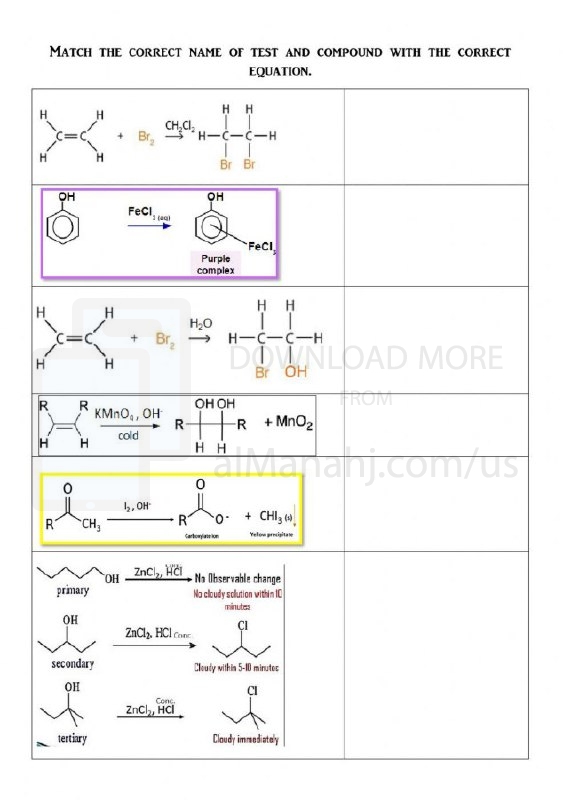| You are here: Almanahj Website ⇒ American curriculum ⇒ 12th Grade ⇒ Chemistry ⇒ Term 1 | ||
|---|---|---|
Chemical test organic chemistry | ||
|---|---|---|
| Subject: Chemistry | ||
| 12th Grade | ||
| Term 1 | ||
| Year: 2023/2024 | ||
| Size: 381.2KB | ||
| Number of clicks: 91 | ||
| Publish date:November 06, 2023 | ||
| Added by: Eman | ||
| Last download date: 2024-09-10 01:50:18 | ||
| Updated by: Eman9966 on 2023-11-06 15:14:13 | By: theodor VINARTI | |
File info: Chemical tests in organic chemistry are used to determine and analyze organic compounds, which are compounds that contain carbon as a fundamental component. These tests are employed to ascertain the structure and molecular composition of organic compounds by observing their chemical reactions and characteristic properties. Here are some commonly used chemical tests in organic chemistry:1. Solubility Test: This test determines the solubility of an organic compound in different solvents, such as water, ethanol, or hydrochloric acid. Solubility characteristics can provide valuable information about the functional groups present in the compound. 2. Combustion Test: The combustion test involves burning a small sample of the organic compound in the presence of oxygen. It helps identify compounds containing carbon and hydrogen, as they undergo complete combustion to produce carbon dioxide and water. 3. Functional Group Tests: Various chemical tests target specific functional groups to identify their presence. For example: - Bromine Test: It detects the presence of unsaturation (e.g., double or triple bonds) by adding bromine water, which decolorizes in the presence of unsaturated compounds. - Lucas Test: This test is used to differentiate between primary, secondary, and tertiary alcohols based on their reactivity with hydrochloric acid and zinc chloride. - Fehling's Test and Tollens' Test: These tests identify reducing sugars and aldehydes, respectively, by their reactions with specific reagents. 4. Chromatographic Techniques: Chromatography is a widely used technique in organic chemistry to separate and analyze organic compounds. Gas chromatography (GC) and high-performance liquid chromatography (HPLC) are common methods that provide information about the composition and purity of organic compounds. 5. Spectroscopic Techniques: Spectroscopy plays a crucial role in identifying and characterizing organic compounds. Some important spectroscopic techniques include: - Infrared Spectroscopy (IR): It provides information about the functional groups present in a compound by measuring the absorption of infrared radiation. - Nuclear Magnetic Resonance (NMR) Spectroscopy: NMR provides insights into the molecular structure and connectivity of atoms within a compound. - Mass Spectrometry (MS): MS identifies the molecular mass and fragmentation pattern of a compound, aiding in structural elucidation. These are just a few examples of the chemical tests employed in organic chemistry. Each test provides unique information about the compound being analyzed, facilitating its identification, characterization, and further study. | ||
| Downloading link Chemical test organic chemistry |
|---|
|
1699282965.pdf
The file is being prepared for download
|
| File images |
|---|
 |